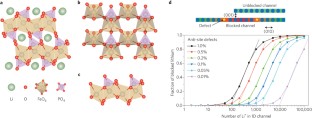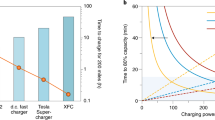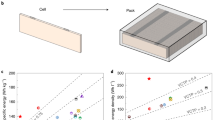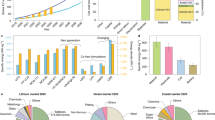Abstract
A significant amount of battery research and development is underway, both in academia and industry, to meet the demand for electric vehicle applications. When it comes to designing and fabricating electrode materials, nanotechnology-based approaches have demonstrated numerous benefits for improved energy and power density, cyclability and safety. In this Review, we offer an overview of nanostructured materials that are either already commercialized or close to commercialization for hybrid electric vehicle applications, as well as those under development with the potential to meet the requirements for long-range electric vehicles.
This is a preview of subscription content, access via your institution
Access options
Subscribe to this journal
Receive 12 print issues and online access
$259.00 per year
only $21.58 per issue
Buy this article
- Purchase on Springer Link
- Instant access to full article PDF
Prices may be subject to local taxes which are calculated during checkout





Similar content being viewed by others
Change history
14 December 2016
In the original version of this Review Article Feng Pan's affiliation should have read: 'School of Advanced Materials, Peking University, Shenzhen Graduate School, Shenzhen 518055, PR China'. This has been updated in the online versions of the Review.
References
Dunn, B., Kamath, H. & Tarascon, J. M. Electrical energy storage for the grid: a battery of choices. Science 334, 928–935 (2011).
Etacheri, V., Marom, R., Elazari, R., Salitra, G. & Aurbach, D. Challenges in the development of advanced Li-ion batteries: a review. Energy. Environ. Sci. 4, 3243–3262 (2011).
Goodenough, J. B. & Park, K.-S. The Li-ion rechargeable battery: a perspective. J. Am. Chem. Soc. 135, 1167–1176 (2013).
Bruce, P. G., Freunberger, S. A., Hardwick, L. J. & Tarascon, J.-M. Li–O2 and Li–S batteries with high energy storage. Nat. Mater. 11, 19–29 (2012).
Lu, J. et al. Aprotic and aqueous Li–O2 batteries. Chem. Rev. 114, 5611–5640 (2014).
Chen, Z., Lu, Z. & Dahn, J. R. Staging phase transitions in LixCoO2 . J. Electrochem. Soc. 149, A1604–A1609 (2002).
Padhi, A. K., Nanjundaswamy, K. S. & Goodenough, J. B. Phospho-olivines as positive-electrode materials for rechargeable lithium batteries. J. Electrochem. Soc. 144, 1188–1194 (1997).
Chung, S. Y., Bloking, J. T. & Chiang, Y. M. Electronically conductive phospho-olivines as lithium storage electrodes. Nat. Mater. 1, 123–128 (2002).
Malik, R., Zhou, F. & Ceder, G. Kinetics of non-equilibrium lithium incorporation in LiFePO4 . Nat. Mater. 10, 587–590 (2011).
Zhang, K. et al. Conformal coating strategy comprising N-doped carbon and conventional graphene for achieving ultrahigh power and cyclability of LiFePO4 . Nano Lett. 15, 6756–6763 (2015).
Lepage, D., Michot, C., Liang, G., Gauthier, M. & Schougaard, S. B. A soft chemistry approach to coating of LiFePO4 with a conducting polymer. Angew. Chem. Int. Ed. 50, 6884–6887 (2011).
Hu, C. et al. Suppressing Li3PO4 impurity formation in LiFePO4/Fe2P by a nonstoichiometry synthesis and its effect on electrochemical properties. Mater. Lett. 65, 1323–1326 (2011).
Herle, P. S., Ellis, B., Coombs, N. & Nazar, L. F. Nano-network electronic conduction in iron and nickel olivine phosphates. Nat. Mater. 3, 147–152 (2004).
Zhang, P. X. et al. First-principles study on the electronic structure of a LiFePO4 (010) surface adsorbed with carbon. J. Alloys Compd. 540, 121–126 (2012).
Nishimura, S.-i. et al. Experimental visualization of lithium diffusion in LixFePO4 . Nat. Mater. 7, 707–711 (2008).
Malik, R., Burch, D., Bazant, M. & Ceder, G. Particle size dependence of the ionic diffusivity. Nano Lett. 10, 4123–4127 (2010).
Yuan, A., Tian, L., Xu, W. & Wang, Y. Al-doped spinel LiAl0.1Mn1.9O4 with improved high-rate cyclability in aqueous electrolyte. J. Power Sources 195, 5032–5038 (2010).
Shkrob, I. A. et al. Manganese in graphite anode and capacity fade in Li ion batteries. J. Phys. Chem. C 118, 24335–24348 (2014).
Kumagai, N., Komaba, S., Kataoka, Y. & Koyanagi, M. Electrochemical behavior of graphite electrode for lithium ion batteries in Mn and Co additive electrolytes. Chem. Lett. 29, 1154–1155 (2000).
Lin, Y.-M. et al. Enhanced high-rate cycling stability of LiMn2O4 cathode by ZrO2 coating for Li-ion battery. J. Electrochem. Soc. 152, A1526–A1532 (2005).
Kim, J.-S. et al. The electrochemical stability of spinel electrodes coated with ZrO2, Al2O3, and SiO2 from colloidal suspensions. J. Electrochem. Soc. 151, A1755–A1761 (2004).
Lu, J. et al. Effectively suppressing dissolution of manganese from spinel lithium manganate via a nanoscale surface-doping approach. Nat. Commun. 5, 5693 (2014).
Yao, J., Shen, C., Zhang, P., Gregory, D. & Wang, L. Surface coating of LiMn2O4 spinel via in situ hydrolysis route: effect of the solution. Ionics 19, 739–745 (2013).
Liu, Y., Lv, J., Fei, Y., Huo, X. & Zhu, Y. Improvement of storage performance of LiMn2O4/graphite battery with AlF3-coated LiMn2O4 . Ionics 19, 1241–1246 (2013).
Komaba, S. et al. Impact of 2-vinylpyridine as electrolyte additive on surface and electrochemistry of graphite for C/LiMn2O4 Li-ion cells. J. Electrochem. Soc. 152, A937–A946 (2005).
Zhan, C., Qiu, X., Lu, J. & Amine, K. Tuning the Mn deposition on the anode to improve the cycle performance of the Mn-based lithium ion battery. Adv. Mater. Interfaces 3, 1500856 (2016).
Sun, Y.-K. et al. The role of AlF3 coatings in improving electrochemical cycling of Li-enriched nickel-manganese oxide electrodes for Li-ion batteries. Adv. Mater. 24, 1192–1196 (2012).
Chebiam, R. V., Kannan, A. M., Prado, F. & Manthiram, A. Comparison of the chemical stability of the high energy density cathodes of lithium-ion batteries. Electrochem. Commun. 3, 624–627 (2001).
Liu, L. & Chen, X. Titanium dioxide nanomaterials: self-structural modifications. Chem. Rev. 114, 9890–9918 (2014).
Chen, Z., Qin, Y., Amine, K. & Sun, Y. K. Role of surface coating on cathode materials for lithium-ion batteries. J. Mater. Chem. 20, 7606–7612 (2010).
Cho, J., Kim, Y. W., Kim, B., Lee, J. G. & Park, B. A breakthrough in the safety of lithium secondary batteries by coating the cathode material with AlPO4 nanoparticles. Angew. Chem. Int. Ed. 42, 1618–1621 (2003).
Chen, Z. & Dahn, J. R. Methods to obtain excellent capacity retention in LiCoO2 cycled to 4.5 V. Electrochim. Acta 49, 1079–1090 (2004).
Meng, X., Yang, X.-Q. & Sun, X. Emerging applications of atomic layer deposition for lithium-ion battery studies. Adv. Mater. 24, 3589–3615 (2012).
Sun, Y.-K., Myung, S.-T., Kim, M.-H., Prakash, J. & Amine, K. Synthesis and characterization of Li[(Ni0.8Co0.1Mn0.1)0.8(Ni0.5Mn0.5)0.2]O2 with the microscale core–shell structure as the positive electrode material for lithium batteries. J. Am. Chem. Soc. 127, 13411–13418 (2005).
Sun, Y. K. et al. Nanostructured high-energy cathode materials for advanced lithium batteries. Nat. Mater. 11, 942–947 (2012).
Noh, H.-J. et al. Cathode material with nanorod structure — an application for advanced high-energy and safe lithium batteries. Chem. Mater. 25, 2109–2115 (2013).
Xu, M. et al. Tris (pentafluorophenyl) phosphine: an electrolyte additive for high voltage Li-ion batteries. Electrochem. Commun. 18, 123–126 (2012).
Abe, K., Ushigoe, Y., Yoshitake, H. & Yoshio, M. Functional electrolytes: novel type additives for cathode materials, providing high cycleability performance. J. Power Sources 153, 328–335 (2006).
Tarnopolskiy, V. et al. Beneficial influence of succinic anhydride as electrolyte additive on the self-discharge of 5 V LiNi0.4Mn1.6O4 cathodes. J. Power Sources 236, 39–46 (2013).
von Cresce, A. & Xu, K. Electrolyte additive in support of 5 V Li ion chemistry. J. Electrochem. Soc. 158, A337–A342 (2011).
Winter, M., Besenhard, J. O., Spahr, M. E. & Novák, P. Insertion electrode materials for rechargeable lithium batteries. Adv. Mater. 10, 725–763 (1998).
Dahn, J. et al. in Lithium Batteries: New Materials, Developments, and Perspectives (ed. Pistoria, G.) Ch. 1 (Elsevier, 1994).
Ohzuku, T., Ueda, A. & Yamamoto, N. Zero-strain insertion material of Li[Li1/3Ti5/3]O4 for rechargeable lithium cells. J. Electrochem. Soc. 142, 1431–1435 (1995).
Park, C.-M., Kim, J.-H., Kim, H. & Sohn, H.-J. Li-alloy based anode materials for Li secondary batteries. Chem. Soc. Rev. 39, 3115–3141 (2010).
Reddy, M., Subba Rao, G. & Chowdari, B. Metal oxides and oxysalts as anode materials for Li ion batteries. Chem. Rev. 113, 5364–5457 (2013).
Endo, M., Kim, C., Nishimura, K., Fujino, T. & Miyashita, K. Recent development of carbon materials for Li ion batteries. Carbon 38, 183–197 (2000).
Buqa, H., Goers, D., Holzapfel, M., Spahr, M. E. & Novák, P. High rate capability of graphite negative electrodes for lithium-ion batteries. J. Electrochem. Soc. 152, A474–A481 (2005).
Aurbach, D., Markovsky, B., Weissman, I., Levi, E. & Ein-Eli, Y. On the correlation between surface chemistry and performance of graphite negative electrodes for Li ion batteries. Electrochim. Acta 45, 67–86 (1999).
Smart, M. C. et al. Irreversible capacities of graphite in low-temperature electrolytes for lithium-ion batteries. J. Electrochem. Soc. 146, 3963–3969 (1999).
Jeong, S.-K., Inaba, M., Abe, T. & Ogumi, Z. Surface film formation on graphite negative electrode in lithium-ion batteries: AFM study in an ethylene carbonate-based solution. J. Electrochem. Soc. 148, A989–A993 (2001).
Kulova, T. L. et al. Electrochemical characteristics of negative electrodes made of ozone-treated graphite for lithium-ion batteries. Russ. J. Electrochem. 37, 1017–1023 (2001).
Li, H. & Zhou, H. Enhancing the performances of Li-ion batteries by carbon-coating: present and future. Chem. Commun. 48, 1201–1217 (2012).
Yoshio, M., Wang, H., Fukuda, K., Hara, Y. & Adachi, Y. Effect of carbon coating on electrochemical performance of treated natural graphite as lithium-ion battery anode material. J. Electrochem. Soc. 147, 1245–1250 (2000).
Yoshio, M., Wang, H. & Fukuda, K. Spherical carbon-coated natural graphite as a lithium-ion battery-anode material. Angew. Chem. Int. Ed. 42, 4203–4206 (2003).
Yoshio, M. et al. Improvement of natural graphite as a lithium-ion battery anode material, from raw flake to carbon-coated sphere. J. Mater. Chem. 14, 1754–1758 (2004).
Gao, J. et al. Suppression of PC decomposition at the surface of graphitic carbon by Cu coating. Electrochem. Commun. 8, 1726–1730 (2006).
Yang, L. C., Guo, W. L., Shi, Y. & Wu, Y. P. Graphite@MoO3 composite as anode material for lithium ion battery in propylene carbonate-based electrolyte. J. Alloys Compd. 501, 218–220 (2010).
Guo, K., Pan, Q. & Fang, S. Poly(acrylonitrile) encapsulated graphite as anode materials for lithium ion batteries. J. Power Sources 111, 350–356 (2002).
Zhang, H.-L. et al. Electrochemical performance of pyrolytic carbon-coated natural graphite spheres. Carbon 44, 2212–2218 (2006).
Park, G., Gunawardhana, N., Nakamura, H., Lee, Y. & Yoshio, M. Suppression of Li deposition on surface of graphite using carbon coating by thermal vapor deposition process. J. Power Sources 196, 9820–9824 (2011).
Nozaki, H., Nagaoka, K., Hoshi, K., Ohta, N. & Inagaki, M. Carbon-coated graphite for anode of lithium ion rechargeable batteries: carbon coating conditions and precursors. J. Power Sources 194, 486–493 (2009).
Ding, Y.-S. et al. Characteristics of graphite anode modified by CVD carbon coating. Surf. Coat. Technol. 200, 3041–3048 (2006).
Lee, M.-L. et al. Atomic layer deposition of TiO2 on negative electrode for lithium ion batteries. J. Power Sources 244, 410–416 (2013).
Lu, W., Donepudi, V. S., Prakash, J., Liu, J. & Amine, K. Electrochemical and thermal behavior of copper coated type MAG-20 natural graphite. Electrochim. Acta 47, 1601–1606 (2002).
Pan, Q., Guo, K., Wang, L. & Fang, S. Novel modified graphite as anode material for lithium-ion batteries. J. Electrochem. Soc. 149, A1218–A1223 (2002).
Veeraraghavan, B., Paul, J., Haran, B. & Popov, B. Study of polypyrrole graphite composite as anode material for secondary lithium-ion batteries. J. Power Sources 109, 377–387 (2002).
Zhang, H.-L., Li, F., Liu, C. & Cheng, H.-M. Poly(vinyl chloride) (PVC) coated idea revisited: influence of carbonization procedures on PVC-coated natural graphite as anode materials for lithium ion batteries. J. Phys. Chem. C 112, 7767–7772 (2008).
Ouyang, C. Y., Zhong, Z. Y. & Lei, M. S. Ab initio studies of structural and electronic properties of Li4Ti5O12 spinel. Electrochem. Commun. 9, 1107–1112 (2007).
Prakash, A. S. et al. Solution-combustion synthesized nanocrystalline Li4Ti5O12 as high-rate performance Li-ion battery anode. Chem. Mater. 22, 2857–2863 (2010).
Rahman, M. M., Wang, J.-Z., Hassan, M. F., Wexler, D. & Liu, H. K. Amorphous carbon coated high grain boundary density dual phase Li4Ti5O12-TiO2: a nanocomposite anode material for Li-ion batteries. Adv. Energy Mater. 1, 212–220 (2011).
Kim, H.-K., Bak, S.-M. & Kim, K.-B. Li4Ti5O12/reduced graphite oxide nano-hybrid material for high rate lithium-ion batteries. Electrochem. Commun. 12, 1768–1771 (2010).
Shen, L., Uchaker, E., Zhang, X. & Cao, G. Hydrogenated Li4Ti5O12 nanowire arrays for high rate lithium ion batteries. Adv. Mater. 24, 6502–6506 (2012).
Chiu, H.-c. & Demopoulos, G. P. A novel green approach to synthesis of nanostructured Li4Ti5O12 anode material. ECS Trans. 50, 119–126 (2013).
Chen, J., Yang, L., Fang, S., Hirano, S.-i. & Tachibana, K. Synthesis of hierarchical mesoporous nest-like Li4Ti5O12 for high-rate lithium ion batteries. J. Power Sources 200, 59–66 (2012).
Laumann, A. et al. Rapid green continuous flow supercritical synthesis of high performance Li4Ti5O12 nanocrystals for Li ion battery applications. J. Electrochem. Soc. 159, A166–A171 (2011).
Bai, Y., Wang, F., Wu, F., Wu, C. & Bao, L.-y. Influence of composite LiCl–KCl molten salt on microstructure and electrochemical performance of spinel Li4Ti5O12 . Electrochim. Acta 54, 322–327 (2008).
Li, J., Jin, Y.-L., Zhang, X.-G. & Yang, H. Microwave solid-state synthesis of spinel Li4Ti5O12 nanocrystallites as anode material for lithium-ion batteries. Solid State Ion. 178, 1590–1594 (2007).
Shen, L. et al. Three-dimensional coherent titania–mesoporous carbon nanocomposite and its lithium-ion storage properties. ACS Appl. Mater. Interfaces 4, 2985–2992 (2012).
Djenizian, T., Hanzu, I. & Knauth, P. Nanostructured negative electrodes based on titania for Li-ion microbatteries. J. Mater. Chem. 21, 9925–9937 (2011).
Liu, H. et al. Mesoporous TiO2–B microspheres with superior rate performance for lithium ion batteries. Adv. Mater. 23, 3450–3454 (2011).
Boukamp, B. A., Lesh, G. C. & Huggins, R. A. All-solid lithium electrodes with mixed-conductor matrix. J. Electrochem. Soc. 128, 725–729 (1981).
Winter, M. & Besenhard, J. O. Electrochemical lithiation of tin and tin-based intermetallics and composites. Electrochim. Acta 45, 31–50 (1999).
Wu, H. & Cui, Y. Designing nanostructured Si anodes for high energy lithium ion batteries. Nano Today 7, 414–429 (2012).
Yoshio, M. et al. Carbon-coated Si as a lithium-ion battery anode material. J. Electrochem. Soc. 149, A1598–A1603 (2002).
Johnson, C. S., Li, N., Lefief, C. & Thackeray, M. M. Anomalous capacity and cycling stability of xLi(2)MnO(3)center dot(1−x)LiMO2 electrodes (M = Mn, Ni, Co) in lithium batteries at 50 degrees C. Electrochem. Commun. 9, 787–795 (2007).
Obrovac, M. N., Christensen, L., Le, D. B. & Dahn, J. R. Alloy design for lithium-ion battery anodes. J. Electrochem. Soc. 154, A849–A855 (2007).
Sandu, I., Moreau, P., Guyomard, D., Brousse, T. & Roué, L. Synthesis of nanosized Si particles via a mechanochemical solid–liquid reaction and application in Li-ion batteries. Solid State Ion. 178, 1297–1303 (2007).
Phan, V. P., Pecquenard, B. & Le Cras, F. High-performance all-solid-state cells fabricated with silicon electrodes. Adv. Funct. Mater. 22, 2580–2584 (2012).
Szczech, J. R. & Jin, S. Nanostructured silicon for high capacity lithium battery anodes. Energy Environ. Sci. 4, 56–72 (2011).
Liu, N. et al. a yolk-shell design for stabilized and scalable li-ion battery alloy anodes. Nano Lett. 12, 3315–3321 (2012).
Chan, C. K. et al. High-performance lithium battery anodes using silicon nanowires. Nat. Nanotech. 3, 31–35 (2008).
Cui, L.-F., Ruffo, R., Chan, C. K., Peng, H. & Cui, Y. Crystalline-amorphous core–shell silicon nanowires for high capacity and high current battery electrodes. Nano Lett. 9, 491–495 (2009).
Hertzberg, B., Alexeev, A. & Yushin, G. Deformations in Si–Li anodes upon electrochemical alloying in nano-confined space. J. Am. Chem. Soc. 132, 8548–8549 (2010).
Choi, N.-S., Yao, Y., Cui, Y. & Cho, J. One dimensional Si/Sn-based nanowires and nanotubes for lithium-ion energy storage materials. J. Mater. Chem. 21, 9825–9840 (2011).
Ma, H. et al. Nest-like silicon nanospheres for high-capacity lithium storage. Adv. Mater. 19, 4067–4070 (2007).
Magasinski, A. et al. High-performance lithium-ion anodes using a hierarchical bottom-up approach. Nat. Mater. 9, 353–358 (2010).
Yin, J. et al. Micrometer-scale amorphous Si thin-film electrodes fabricated by electron-beam deposition for Li-ion batteries. J. Electrochem. Soc. 153, A472–A477 (2006).
Mazouzi, D., Lestriez, B., Roué, L. & Guyomard, D. Silicon composite electrode with high capacity and long cycle life. Electrochem. Solid State Lett. 12, A215–A218 (2009).
Chan, C. K., Patel, R. N., O'Connell, M. J., Korgel, B. A. & Cui, Y. Solution-grown silicon nanowires for lithium-ion battery anodes. ACS Nano 4, 1443–1450 (2010).
Liu, N. et al. A pomegranate-inspired nanoscale design for large-volume-change lithium battery anodes. Nat. Nanotech. 9, 187–192 (2014).
Xu, W. et al. Lithium metal anodes for rechargeable batteries. Energy. Environ. Sci. 7, 513–537 (2014).
Cheng, X.-B. et al. A review of solid electrolyte interphases on lithium metal anode. Adv. Sci. 3, 1500213 (2015).
Kim, J.-S., Kim, D. W., Jung, H. T. & Choi, J. W. Controlled lithium dendrite growth by a synergistic effect of multilayered graphene coating and an electrolyte additive. Chem. Mater. 27, 2780–2787 (2015).
Van Noorden, R. A better battery. Nature 507, 26–28 (2014).
Nazar, L. F., Cuisinier, M. & Pang, Q. Lithium-sulfur batteries. MRS Bull. 39, 436–442 (2014).
Manthiram, A., Fu, Y. Z. & Su, Y. S. Challenges and prospects of lithium–sulfur batteries. Acc. Chem. Res. 46, 1125–1134 (2013).
Yin, Y. X., Xin, S., Guo, Y. G. & Wan, L. J. Lithium–sulfur batteries: electrochemistry, materials, and prospects. Angew. Chem. Int. Ed. 52, 13186–13200 (2013).
Zhang, B., Qin, X., Li, G. R. & Gao, X. P. Enhancement of long stability of sulfur cathode by encapsulating sulfur into micropores of carbon spheres. Energy. Environ. Sci. 3, 1531–1537 (2010).
Liang, C. D., Dudney, N. J. & Howe, J. Y. Hierarchically structured sulfur/carbon nanocomposite material for high-energy lithium battery. Chem. Mater. 21, 4724–4730 (2009).
Ji, X. L., Lee, K. T. & Nazar, L. F. A highly ordered nanostructured carbon-sulphur cathode for lithium-sulphur batteries. Nat. Mater. 8, 500–506 (2009).
Seh, Z. W. et al. Sulphur–TiO2 yolk-shell nanoarchitecture with internal void space for long-cycle lithium-sulphur batteries. Nat. Commun. 4, 1331 (2013).
Song, M. K., Zhang, Y. G. & Cairns, E. J. A long-life, high-rate lithium/sulfur cell: a multifaceted approach to enhancing cell performance. Nano Lett. 13, 5891–5899 (2013).
Chen, R. J. et al. Graphene-based three-dimensional hierarchical sandwich-type architecture for high-performance Li/S batteries. Nano Lett. 13, 4642–4649 (2013).
Lu, J. et al. A lithium–oxygen battery based on lithium superoxide. Nature 529, 377–382 (2016).
Lu, J. et al. A nanostructured cathode architecture for low charge overpotential in lithium–oxygen batteries. Nat. Commun. 4, 2383 (2013).
Acknowledgements
This work was supported by the US Department of Energy under Contract DE-AC0206CH11357 with the main support provided by the Vehicle Technologies Office, Department of Energy (DOE) Office of Energy Efficiency and Renewable Energy (EERE). We also acknowledge support from the Chinese Electric Power Research Institute (CEPRI).
Author information
Authors and Affiliations
Corresponding authors
Ethics declarations
Competing interests
The authors declare no competing financial interests.
Rights and permissions
About this article
Cite this article
Lu, J., Chen, Z., Ma, Z. et al. The role of nanotechnology in the development of battery materials for electric vehicles. Nature Nanotech 11, 1031–1038 (2016). https://doi.org/10.1038/nnano.2016.207
Received:
Accepted:
Published:
Issue Date:
DOI: https://doi.org/10.1038/nnano.2016.207
This article is cited by
-
Precision ion separation via self-assembled channels
Nature Communications (2024)
-
Sequencing polymers to enable solid-state lithium batteries
Nature Materials (2023)
-
Preparation of double-shell Si@SnO2@C nanocomposite as anode for lithium-ion batteries by hydrothermal method
Rare Metals (2023)
-
Investigation of reduced lithium titanate spinel as insertion host for rechargeable batteries
Korean Journal of Chemical Engineering (2023)
-
Electrical investigation and enhancement of optical, structural, and dielectric properties of flexible PVDF/LiZnVO4 nanocomposites
Discover Materials (2023)



